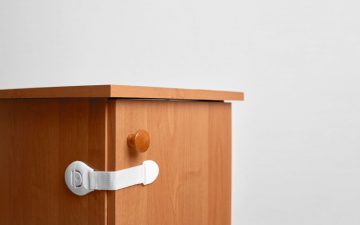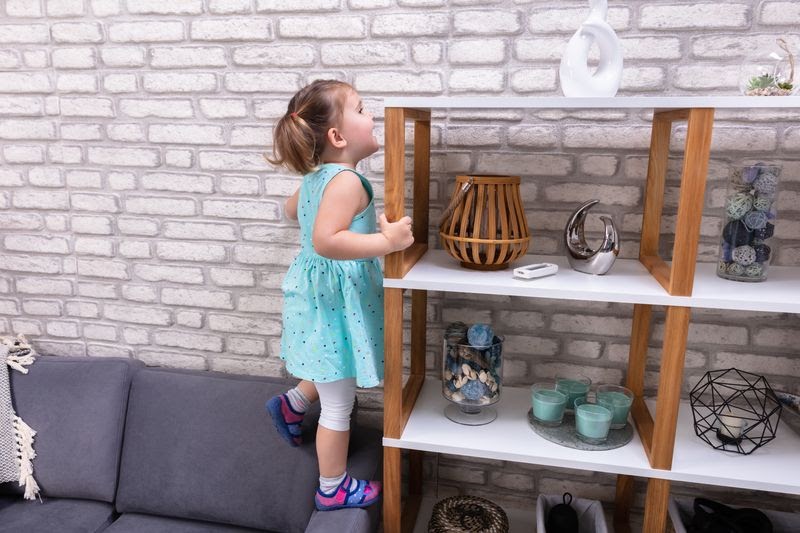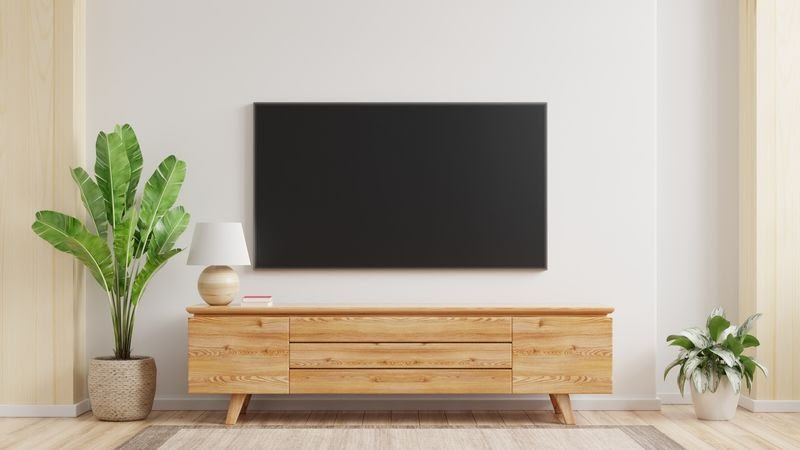
As a parent of small children, you don’t want to hear a loud thud at home followed by your child’s cry, especially when you’re not in the immediate vicinity and, therefore, too late to stop an accident. For this reason, you’re determined to look after your little one at all times.
But it’s impossible to have your eyes on your child every second of the day. You might have to run some errands or simply turn away from them to prepare their food or fold their clothes. At the same time, it’s in these brief moments that your child could tip over a piece of heavy furniture and get injured.
To prevent injuries, keeping child safety in mind is critical in building your home environment. This article will discuss how to keep your kids safe from tipping injuries with furniture placement tips and anti-tip furniture straps!
What are the Most Common Injuries Kids Get From Furniture Tip-Overs?
Unstable furniture and other household items can cause various injuries for kids—both minor and fatal cases. The most common tip-over injuries are:
- Broken bones
- Bone dislocations
- Bone fractures
- Open wounds
- Chest injuries
- Amputations
- Brain injuries
- Asphyxiation (due to the crushing weight of furniture)
- Concussions
- Closed head injuries
- Other internal injuries
Compared to adults, a child’s body is way more delicate. Hence, they’re at higher risk of injuries and need a lot of attention and care.

Seven Problem-Solving Tips to Prevent Furniture Tip-Overs
Thousands of children face fatal accidents caused by furniture tip-overs. Some of them happen when the parents are not around to prevent it, which is dangerous. That is why it’s important to take preventative measures against these hazards. We understand that there are times when you can’t be right by your baby’s side, so here are some tips for setting you at ease.
#1: Implement Proper Object Placement
Problem: Curious kids love to reach out on top of elevated surfaces. Examples include tables, chairs, dressers, and TV stands. Unfortunately, heavy furniture can become unstable and fall over more than you think. Sometimes, an effortless push can cause the center of gravity to shift and tip the furniture over.
Solution: Place heavy furniture closer to low drawers or shelves. Then, do the same with objects that trigger curiosity and temptation; don’t place them on any other furniture or appliances like TVs. If possible, keep them completely out of sight and out of reach from your kid. That way, you can significantly minimize the risk of tip-over accidents.
#2: Install Appropriate Anchoring Devices
Problem: Sometimes, the right placement is not enough to ensure furniture stability. Even if it’s close to the wall or placed on lower shelves, some factors can still cause it to fall (e.g., accidentally knocking it over or earthquakes). As a result, it remains a safety hazard.
Solution: Anchoring devices are wall and floor tools that help secure furniture, appliances, and other heavy objects that need solid stability. The different anchoring devices include anti-tip furniture anchor straps, braces, brackets, and cabinet locks.
#3: Furniture Buying Considerations
Problem: Poor quality furniture can cause tip-overs to happen more often. Some products don’t have enough sturdy legs or bases, which triggers the furniture to become dysfunctional and harmful to use.
Solution: Invest in reliable furniture pieces. Aside from the dimensions, design, brand, and price, look for stability and security features. Moreover, test the item before you purchase it. Keep you and your child’s safety in mind when buying items for your home.
#4: Redirect the Location of Active Play
Problem: Children have so much energy. It melts the stress away when you see them all bright and gay. However, it can also cause accidents at home, especially when furniture is involved. In the blink of an eye, your child might knock over a huge shelf or bump on an old TV, leading to an injury.
Solution: It would be best to dedicate a specific area that doesn’t have much or any furniture, so your child can play with high spirits and avoid tip-overs. Moreover, offer them the freedom of outdoor play. Outdoor areas like playgrounds allow them to move freely within safe measures.

#5: Use Wall-Mounted TVs
Problem: The TV is a tempting object for kids; they like seeing active light and movement. Sometimes, they attempt to touch the screen when completely immersed in it. What if the TV is heavy and isn’t stable enough? It can fall over and hurt your child. Hence, it becomes a tip-over hazard.
Solution: If you’re using flat-screen TVs, it is best to have them wall-mounted with an anti-tip strap for complete security. Meanwhile, older TVs are discouraged because they’re bulkier and heavier. If you have one at home and can’t dispose of it, avoid placing it on top of dressers or other furniture. Additionally, put the cords in a safe corner to avoid tripping over when you walk across them.
#6: Respond to a Child’s Desire for Independence
Problem: It’s wonderful to see your child grow and try to accomplish tasks independently—dressing up, putting their toys in proper places, or eating in a regular chair. Still, you shouldn’t take it easy. Achieving these tasks will still require more than your kid can handle. For example, the dresser might be difficult to open, or your kid might fall off the regular chair.
Solution: You don’t have to do everything for them. Instead, you can help them develop a sense of self-sufficiency, but in safer ways. Opening the dresser, for instance, may require strength beyond your child’s capacity. So do the opening or lifting for them, then let the kid focus on choosing the clothes they want to wear instead.
#7: Monitor Your Child Using a Home Security System
Problem: You can’t stay in one area all the time. Consequently, your kid may be out of your sight, which can make any parent uneasy. Some take alternatives, such as getting help from a caretaker or babysitter, but it might not make you feel at ease, either.
Solution: This is where a security system comes in handy. Thanks to technology, you can still keep an eye on your kid even when you’re not around them. Install cameras around the house and turn on notifications for alarming situations. Most security systems also allow you to sync devices for easy access. They make parenting easier and give more freedom to your child.

Get Your Babyproofing Essentials From Ashtonbee
Furniture tip-overs are still prevalent, though authorities keep an eye on safe and stable furniture production. While that’s something you can’t control, you can start minimizing risks at home. The good news is there are very simple preventive measures that you and your child can benefit from.
Learn about safe furniture placements, especially for bulky and heavy objects. Install anti-tip devices, such as anti-tip straps for furniture to prevent them from falling off. Buy furniture wisely. Encourage outdoor play or build areas far from the furniture. Lastly, use a security system and redirect your child’s self-sufficiency in safer ways.
Ashtonbee’s Safety Devices for Your Little One
If you’re looking for high-quality babyproofing devices, consider Ashtonbee’s products. We offer the following safety items you can choose from, from the best anti-tip furniture straps to drawer safety locks.
- Anti-tip TV strap for reliable babyproofing and earthquake prevention.
- High chair for small spaces if you don’t want your kid to use a regular dining chair yet.
- Potty training seat with an adjustable ladder for stress-free toilet business and developing your child’s independence.
- Drawer locks to prevent your baby’s access to off-limit tools and storage spaces.
- Toddler bed rails to keep your little one from falling off the bed.
- Corner guards to protect your toddler from furniture edge hazards.
- Electrical outlet covers for protection against electrical hazards.
Our devices incorporate safety standards, durability, and versatility to help you and your little one take things one baby step at a time. Babyproof your home today!

